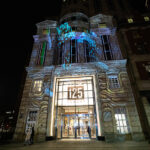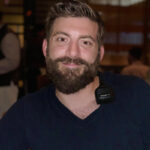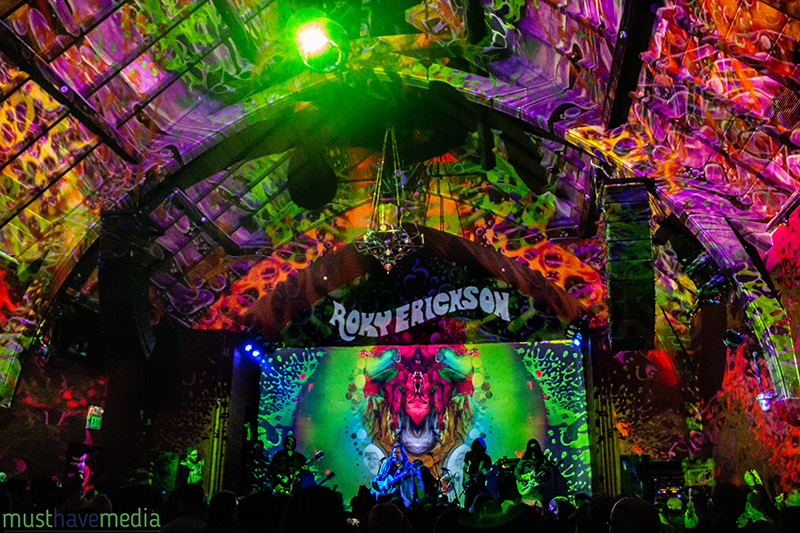
The Magic Elixir of Light
Mystical tomes have been written about both visionaries and charlatans in their quasi-scientific pursuit to unlock the mysteries of the universe and discover the magic elixir of life. In crudest terms, alchemical process is, and was, an occult method of combining two ingredients, which results in a new, third element. For others, alchemy was nothing short of exploring the possibility of achieving perfection of human spirit.
Meet liquid lighting designer Lance Gordon, principal of Mad Alchemy, who chases perfection and the “new” every night through intuition, chemical reactions, and a nearly esoteric concoction of common ingredients, such as oil, alcohol, dye and ink, creative ideas, and an interconnection of analog and digital hardware. Operating in the middle of a crowd or from his secluded station at the side of the stage, Gordon works in tandem with his dedicated assistants, like a master and his apprentices experimenting in a Medieval lab.

Psychedelic Roots
Although he began liquid lighting design in the early 1970s, Gordon was given new life and lured back into performing liquid light shows about a decade ago. From Northern California, he shuttles around the country and makes regular appearances in the San Francisco Bay Area — ground zero for the psychedelic movement of the 1960s.
Once a forgotten relic of the distant past, liquid light shows have seen an uptick in popularity, thanks in no small part to the resurgence of psychedelic rock, festivals that cater to fans of this style. The analog components of Mad Alchemy’s shows have had a strange appeal to the younger “digital revolution” generation.
“We do only liquid projection,” says Gordon proudly. “We do not incorporate any slides, artwork, film, and, generally speaking, lasers. Dennis Keefe, our designer, will bring in lasers.”
Some hard-core festivalgoers, culture critics and musicians alike swear by Gordon’s work and are transfixed on Mad Alchemy’s ability to improvise upon or cook up a bubbling, pulsating, chemical-based micro-conflict between alcohol and oil. Modified projectors provide the battleground for a series of alternating construction and destruction processes, fostering an immersive environment that some observers might equate with the hallucinogenic process of “ego loss.”
It’s been a long strange trip, as they say, for Gordon to arrive at this point in his career, however. To hear Gordon explain it, he was nearly predestined to be a liquid light show designer. “As soon as I saw my first light show, in 1969, I wanted to do this,” says Gordon. “I was a drummer in a little rock band, in eight, ninth grade, and this was Northern California. I didn’t think I was good enough but, in retrospect, I probably hadn’t done it long enough. Then, again, I really wanted to do lights.”
As a young lighting designer, Gordon had used, essentially, a series of slide and film projectors. “We struggled along for years and we didn’t figure out the chemistry [for doing liquid light shows],” says Gordon. “It wasn’t common knowledge. No one wanted to tell you how any of this stuff was done.”
A chance meeting with an acquaintance, “a raging heroin addict,” educated Gordon on, among other things, “the oil-alcohol combination” needed to perform his own light experiments. Gordon began applying this “occult” knowledge during concerts in the San Francisco Bay Area throughout the 1970s, collaborating with Tower of Power, Elvin Bishop, John Cipollina of Quicksilver Messenger Service, Boz Scaggs, and blues icons such as John Lee Hooker.
It was a freer time, with space for both musician and visual artist to learn and explore. As the ‘70s wore on and the psychedelic haze faded, the era of liquid light waned, and a new breed of rock show had emerged. “None of the names in liquid light rose to the same level of prominence as the musicians,” says Gordon. “A conventional lighting show is difficult. It can be done, but some in the liquid light arena weren’t up to it. Stage lighting just took over.”
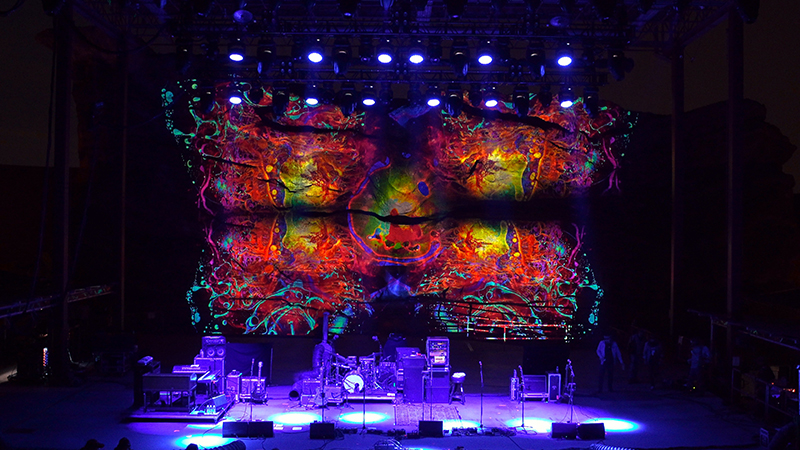
A “True Gemini”
Gordon sought other avenues to make dough, including as a struggling rock photographer. Eventually Gordon found his way to a more lucrative career in architectural photography. Throughout his time in the industry, something was nagging at him, though, nearly beckoning him back to his visual roots.
“I’m a true Gemini,” Gordon says. “Passion to do these shows had laid dormant inside me, really, from the late 1970s.”
In 2001, while on a break from a project he was working on in the Bay Area, Gordon attended a show at the Fillmore, and something inside him just clicked — or maybe the correct word is snapped. “It was a new band night and these acts had no light show,” says Gordon. “I was there in 1969 and seeing this in 2001? It was like devolution.”
Taking shelter from the economic downtown in the architecture field and housing market, circa 2008, Gordon found himself in Salt Lake City. “I thought I’d do liquid light shows again,” says Gordon. “I thought I’d do this for a few years and then get back to the corporate world. I had no idea how younger people were going to respond.”
In the Salt Lake City area Gordon met Rick Gerber of Labcoat and Ulysses. Working with Gerber provided Gordon his entrée back into the live and lighting worlds. Much of what he had ingested from his photo career spilled over into his working as a liquid lighting designer. “I learned full-frame composition, and that is really important when you’re doing performance art on the fly,” says Gordon. “When you think of a screen it can be the same thing as a viewfinder and a camera, it is just much larger. You have a composition you’re working on.”
Mad Alchemy’s first show of the new era was at Austin’s Psych Fest, also known as Levitation, in 2008. “The Psych Fest became a focal point,” says Gordon, “and after that, I took my light show on the road, playing all these crazy places.”
Eventually, Gordon met Radio Moscow, led by guitarist Parker Griggs, at the Urban Lounge in May 2011, and built a relationship with the band that solidified his place in the neo-psyche and stoner rock worlds. Gordon’s return to so-called psychedelia coincides with the upturn in popularity of this style of music.
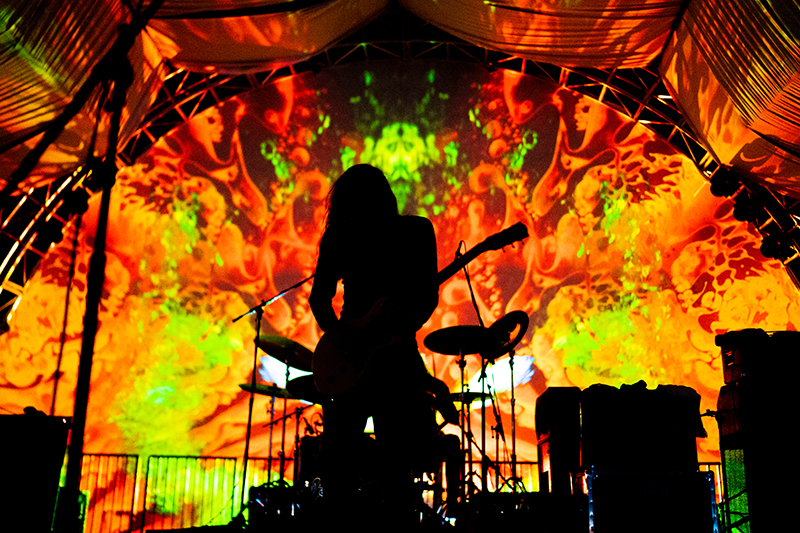
Liquid Light for a New Era
“From what I understand, [a younger generation] has grown up with computer-generated images and effects, some of which I like,” says fellow light show designer Jim Baldocchi of Projection Art. “Computer shows can be programed, but with analog, the process tends to be done spontaneously, and there’s also the impermanence of the art you are seeing. Yes, it can be documented, but usually there’s a significant difference between the live show experience as compared to a taped version.”
“What I liked about Mad Alchemy, when we toured with them, was their ability to create an environment,” says Senon Williams, visual artist, author and bassist for Los Angeles-based Dengue Fever, fronted by Cambodian-born lead singer Chhom Nimol. “It’s kind of like going to the Redwood forest or cathedrals of Europe. You can see outside yourself. Maybe a liquid light show triggers that idea in people. Being overwhelmed by art is affirmative of life in some strange way.”
Gordon estimates that he’s done upwards of 1,500 shows since Mad Alchemy’s reboot in 2008, including festivals such as Desert Daze at Lake Perris in California and the inaugural year of Monolith on the Mesa, just this last May in Taos, New Mexico. Mad Alchemy is practically a fixture at the Bay Area venue, The Chapel in San Francisco, and he’s performed at the historical Fox Oakland Theater.
In just the last two years, Mad Alchemy’s show has evolved to include digital aspects. Just prior to appearing at Red Rocks in 2017 with the Colorado-based electronic-based rock duo BoomBox, a chance meeting with light show veteran Dennis Keefe, Jim Baldocchi’s partner in Projection Art, led to a technical upgrade that changed the course of Gordon’s liquid light presentation and career. “Dennis said he could do up to 16,000 lumens,” says Gordon. “I hired him to work with us on this show. He brought down his equipment and built this system for me.”
“Lance was using old portable Dukane projectors, and mid-level ones at that,” says Keefe. “I gutted those projectors, took out the bulb mechanism, and put in an LED color changing system, like an old- fashioned color wheel, and that became the light source. It’s low energy and the power demand is down. The camera for each unit is a 1080p type.”
“The plates are filmed by these hi-definition cameras,” says Gordon. “The camera sits on the bar where the mirror of the overhead used to be. We’re sending that information, either HDMI or SDI cable, to Roland mixers, and from there we determine where these images go.
“The older analog equipment gives the images a real beautiful, patina softness,” Gordon continues, “but it’s not bright, and it’s hard for that light to live in a modern stage environment. With the digital aspects of the show, the imagery bleeds off the screen.”
Gordon uses a cocktail of ingredients for his presentations, such as mineral oil, rubbing alcohol, dye mixtures, transparent ink, Mylar (for an “Aurora Borealis effect,” says Gordon), clock faces, the aforementioned modified overhead projectors (using a combo of anywhere from four to eight or ten), and an Epson 8K projector or even LED video walls, if the opportunity arises. At some festivals, Gordon will operate from the side of, or “from behind,” the stage and project onto a scrim.
He expands, “The scrim is an interesting element, because the wind will move it back and forth. It’s kind of alive. At the [Taos, NM] Monolith on the Mesa festival, we had aluminum rail that we hang our flying projectors on. It’s up about nine feet, and we can shoot directly onto the bands.”
Collaborating with acts such as Radio Moscow and Earthless has inspired Gordon to be more creative in his approach. Mad Alchemy uses what Gordon calls rhythm plates, which are manipulated by hand during the performances, in real time, and “played like a snare drum” in sync with the rhythmic patterns of the music.
“With a band like Radio Moscow, it’s an onslaught of sound,” says Gordon. “I play the plates, hitting them. Usually we have two plates in circulation. We have a top plate and a bottom one and have liquid in both.”
Visual Stereo Effects
Mad Alchemy also often incorporates two main video projectors, for stereo effects, or what designer Keefe calls “vortex imagery.” It’s contributed to the depth of Gordon’s work. “The stereo thing is fascinating, because you have the possibility of having all of these different creations and faces and organic shades that you could not get with a conventional projection,” says Gordon.
“That opens the imagery to all sorts of forms, which anthropomorphize what Mad Alchemy is doing,” says vocalist/guitarist Jason Simon of Dead Meadow. “It’s like seeing faces in rock formations.”
Analog, digital — what’s old is new again. As was done for him, Gordon passes on the dark art of liquid lighting to apprentices such as Dominic Cota, who has been with Mad Alchemy since 2014.
“Lance, who was doing this back in the day, brought Dominic in and they have helped each other move forward,” says Jason Simon of Dead Meadow. “This is an actual craft Lance honed, and it is being passed on to Dominic.”
“Dominic, and when I’m working myself, [we] look at the mixer screen.” says Keefe. “Lance usually doesn’t. What you have there are various feeds coming, and it’s in the ability of the mixer to help create something new.”
“The guys who help assist Lance, their hands are stained up to their wrists,” says Dengue Fever’s Senon Williams. “The skin is permanently dyed from the inks they use, like some Native American shaman.”
Mad Alchemy will continue to “paint” for their art while on the road throughout the fall of 2019 with artists, such as funky electronica act Slenderbodies and Sinkane (Sudanese-American musician, Ahmed Abdullahi Gallab). Gordon will be performing with Keefe and his optical “light bending” approach at the Hangtown Festival in Placerville, CA and Levitation Festival in Austin this fall.
“I really like a lot of the younger artists,” says Gordon, “and I like my evolution. In some respects I’ve been able to combine different aspects of what I’ve done. I’m 66 years old. I’m blessed to have the energy.”
For more information, visit www.madalchemy.net
